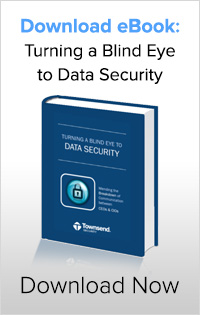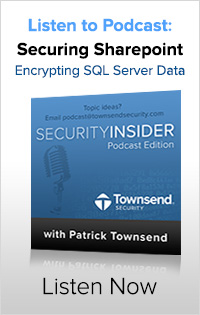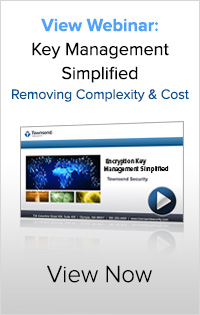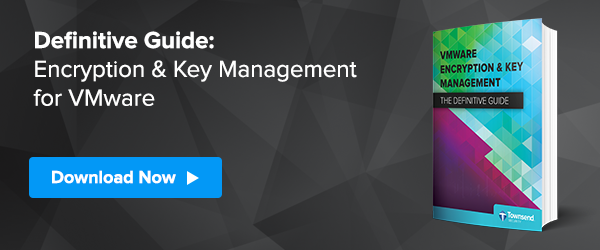Townsend Security recently asked business executive and mid-market expert Todd Ostrander to contribute his expertise and thought leadership on C-level risk management to our most most recently published eBook, Turning a Blind Eye to Data Security (Mending the Breakdown of Communication Between CEOs and CIOs).

In his article, Todd Ostrander discusses several key points around data security and business risk including:
- The roles and responsibilities of a CEO around data security
- The high costs associated with a data breach
- How unencrypted data represents a significant business risk
- Why proper encryption key management is needed to prevent a breach
In addressing these issues, Todd Ostrander urges us to implement the solution that many businesses have yet to adopt.
Read an excerpt from his article below:
“In any organization, the CEO has many jobs. At the macro level, a CEO’s job is to instill a high level of confidence in his or her stakeholders, including customers, investors, employees, suppliers and partners. To accomplish this, a CEO must establish a level of trust with these stakeholders in order to inspire, encourage, and engage them to take part in the entity’s vision and pursuits. Ultimately, the organization uses its stakeholders’ trust—their confidence in the CEO and his or her team’s ability to execute—to grow and build its value.
Every business has inherent risks in its execution—such as hiring dependable employees and maintaining financial stability. In order for a CEO to instill the kind of confidence that increases a business’ value, he or she must be able to identify and address each of the risks in the business. Therefore, risk mitigation by nature becomes a core component of a CEO’s job.
In a pre-internet world, the risk of data loss was limited to a physical breach of an actual building. Security guards, fences, and access control systems were established to keep people away from sensitive information. However, as today’s world has become electronically connected at virtually every level, businesses need to focus not only on preventing access to data but also on protecting the data itself. This is where a comprehensive data protection strategy comes in to play.
Most CEOs are well aware that encryption methodologies were created for their CIOs to be able to protect data in their networks. However, encryption is such a new field that few CEOs understand all of the risks associated with unprotected data as well as evolving industry-based regulations which they must comply with.
CEOs may not know that even if their data is encrypted, without proper encryption key management, they are still at risk and do not comply with many industry regulations. Without good key management practices, you are practically inviting hackers to break in to your system…"
 Todd Ostrander is a professional with over 25 years of F1000, mid-market and emerging market startup experience. Throughout his career, he has been at the forefront of groundbreaking changes that create new markets and opportunities. While he has a broad range of skills from finance to procurement, strategic marketing and product strategy, his core functional expertise is in exploiting existing markets as well as identifying and creating new market opportunities with specific focus on go-to-market, intellectual property, and capitalization strategies. Within the technology industry, he has specific expertise in workflow management, Software as a Service (SaaS), wireless, digital marketing, and mobility.
Todd Ostrander is a professional with over 25 years of F1000, mid-market and emerging market startup experience. Throughout his career, he has been at the forefront of groundbreaking changes that create new markets and opportunities. While he has a broad range of skills from finance to procurement, strategic marketing and product strategy, his core functional expertise is in exploiting existing markets as well as identifying and creating new market opportunities with specific focus on go-to-market, intellectual property, and capitalization strategies. Within the technology industry, he has specific expertise in workflow management, Software as a Service (SaaS), wireless, digital marketing, and mobility.







 Kevin Beaver is an independent information security consultant, expert witness, author, and professional speaker with over 24 years of experience in IT - the last 18 of which he’s dedicated to information security. Before starting Principle Logic in 2001, he served in various information technology and security roles for several healthcare, e-commerce, financial firms, educational institutions, and consulting organizations. Kevin Beaver has written 32 whitepapers, over 600 articles, and authored/co-authored 10 books on information security. Visit Kevin’s blog to learn more about information security, and his website to learn more about his business, Principal Logic.
Kevin Beaver is an independent information security consultant, expert witness, author, and professional speaker with over 24 years of experience in IT - the last 18 of which he’s dedicated to information security. Before starting Principle Logic in 2001, he served in various information technology and security roles for several healthcare, e-commerce, financial firms, educational institutions, and consulting organizations. Kevin Beaver has written 32 whitepapers, over 600 articles, and authored/co-authored 10 books on information security. Visit Kevin’s blog to learn more about information security, and his website to learn more about his business, Principal Logic.


